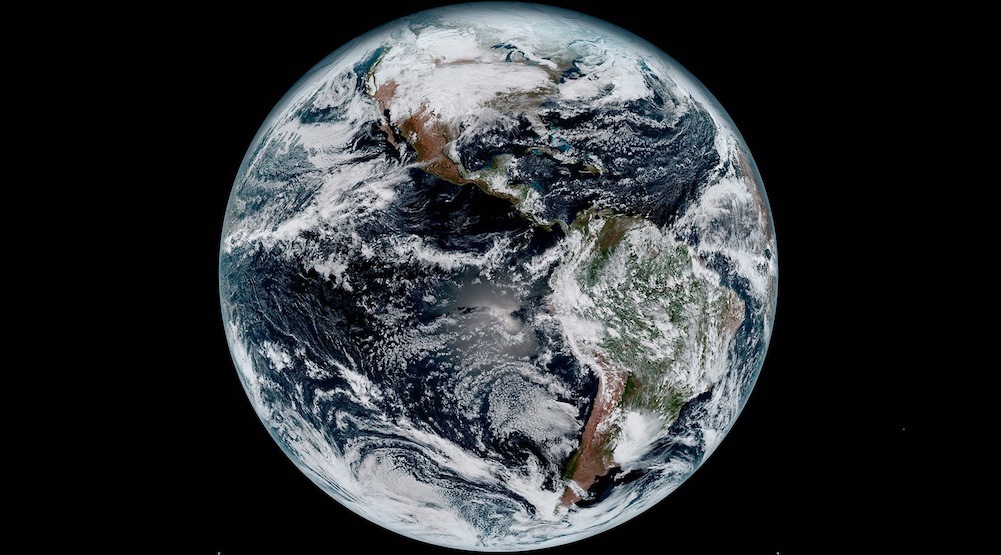
by Rick O'Connor | Nov 3, 2025
In Part 1 of this series, we mentioned many of the issues that mankind is facing, but climate change may be the largest. In this series we have taken a journey on how humans got to this point. We began with our origins and how we dispersed across the planet. Our need for resources, such as food, water, space, and energy. And how our uncontrolled population growth has led to a greater need for these resources and the environmental impact obtaining them has caused. So, here we are… a planet of 8 billion people all seeking and competing for needed resources. Our methods of obtaining them have actually led to something unfathomable… we are actually changing the climate – and this could have several negative impacts for us.

Our fragile Earth
Photo: NOAA
Much of the change in climate is due to the increased production of carbon dioxide, methane, and other “greenhouse gases”. Most of the greenhouse emissions are from industrial processing and the burning of fossil fuels. These gases act as a greenhouse layer for the planet – allowing solar radiation through the atmosphere to heat the surface – but blocking rising heat from escaping – causing a rise in global temperatures.
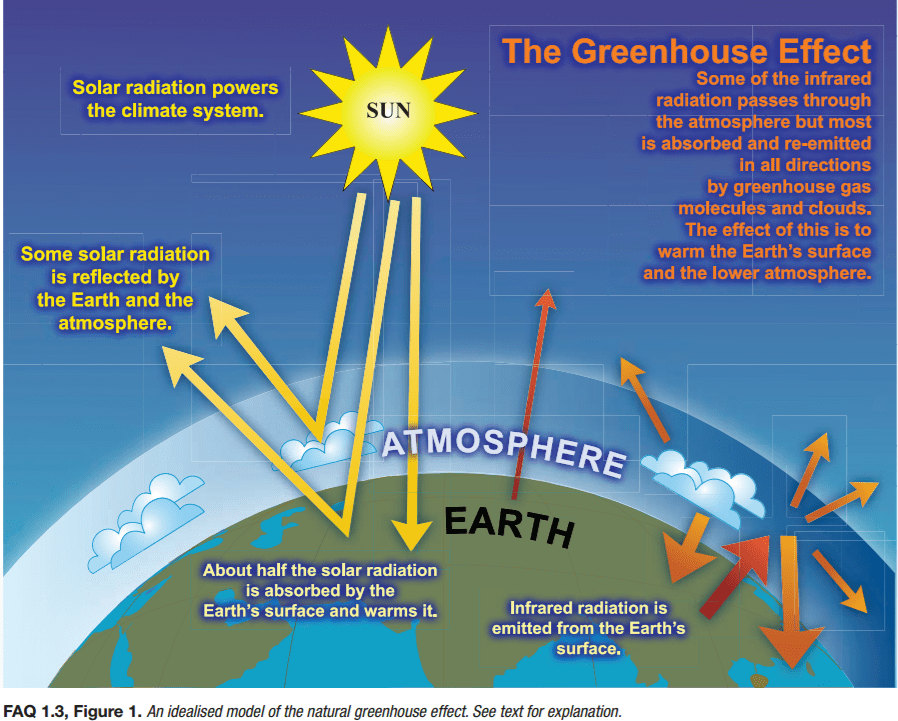
The greenhouse effect.
Image: NOAA
Everyone has seen the graphs of both carbon emissions and global temperature changes over the last couple of centuries. The acceleration of this warming began during the industrial revolution and continued to increase during the 20th century.
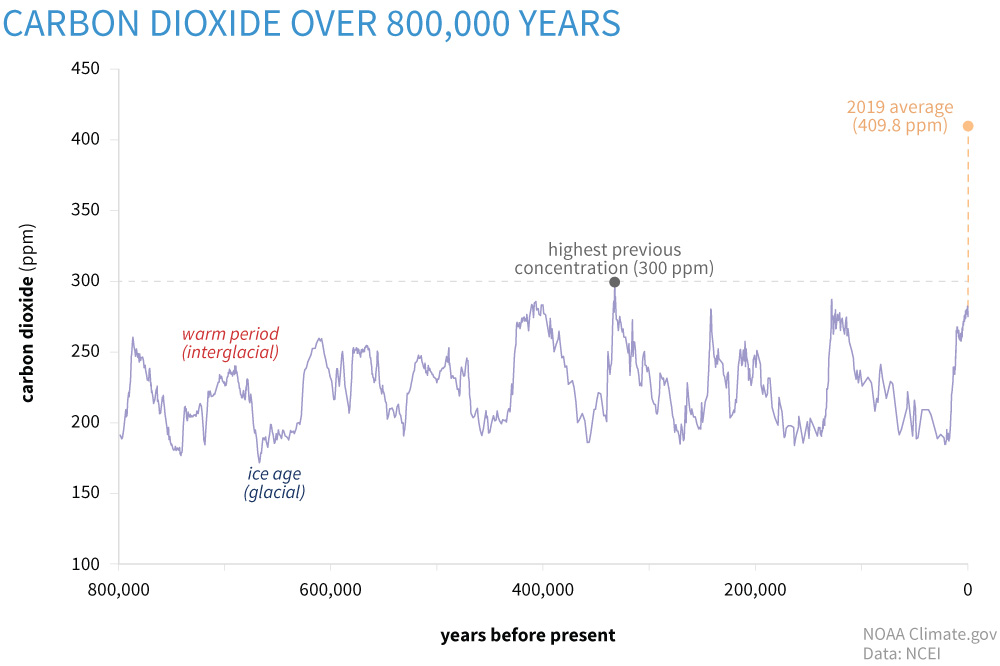
Changes in carbon dioxide levels up to 2019.
Image: NOAA
Our planet actually functions well under a natural form of greenhouse. Carbon dioxide released by photosynthetic plants, volcanic eruptions, and other natural processes, provides a layer in the atmosphere that creates a climate system that allows creatures to survive. The equatorial portion of our planet receives the greatest amount of solar energy and the heat produced from this is moved towards the poles by the ocean and wind currents – dispersing heat to places that would otherwise be colder than they are. However, the increased production of greenhouse gases has escalated the warming.
The oceans have been described as “heat sinks” – collecting heat near the equator and dispersing it further north via the ocean currents. These currents rotate clockwise in the northern hemisphere carrying the warmer water along the western shores of the oceans – eastern Asia and North America – creating wetter, more humid climates – dissipating much of the heat by the time it reaches the poles. The cooler currents then pass the eastern shores of the oceans – western North America, Europe, and Africa – where humidity and rainfall are less. Warm ocean currents provide warm humid air over the land creating rainfall and densely vegetated ecosystems – such as the southeastern United States, and southeast Asia. Cool ocean currents do the opposite – creating arid ecosystems.
Climate models have suggested that a warmer ocean could intensify this process. Warmer land and water will cause a warmer air mass above them. Warm air rises, which decreases the air pressure over that portion of the earth’s surface creating what we call low pressure cells-low pressure systems. As many of us know, low pressure cells create storms, and we have experienced more intense storms all over the country. In the last few years these intense storms have created intense flooding events and tropical storms. One community in the Big Bend of Florida has experienced 3 tropical storms in 13 months. The drier conditions of the cold current coasts have intensified wildfires. All of these changing climatic effects have come at a great cost – both in property damage and in human lives. They have also increased the cost of trying to manage them and will most likely increase cost of insurance to rebuild from these disasters.
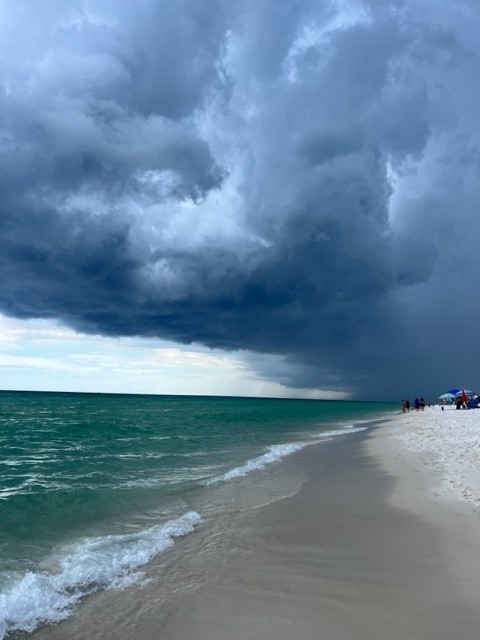
This squall line formed early in the morning. One of many morning thunderstorms formed over a period of a week in the summer of July 2023.
Photo” Rick O’Connor
There are also the impacts of climate on the rest of the planet. Warmer months could cause, and have caused, changes in the local biology. There are reports of lobsters moving north from Maine to Canada; this could happen for other fisheries as well. You will (have) seen the same in agriculture. Planting zones have slowly migrated north forcing farmers to re-think what they are growing on their land – what crops can they support. We could see similar impacts on aquaculture, timber, and more.
Another impact that is already playing out is the lack of water in the drier areas of the planet. The American southwest has already experienced “water wars” and it will continue to be a problem – possibly escalating in the future.
The basic solution to this problem is simple – either reduce the amount of greenhouse gases we are releasing (re-think how we obtain our energy needs), develop methods of removing greenhouse gases from the atmosphere (and before we release), or both.
Easier said than done…
Our investments, and comfort, with fossil fuels are very deep. Many energy companies have been developing new energy technologies for the last few decades – but it is expensive to convert an entire energy system – it will take time and money – both that seem to be in short supply at this time. That said, this issue is not going away and our communities need to move closer to solving them. The University of Florida, and many other universities, have been experimenting and developing methods to help turn this thing around. If your community, business, or agency has questions, or need more information, on this topic – reach out to your local county Extension office.
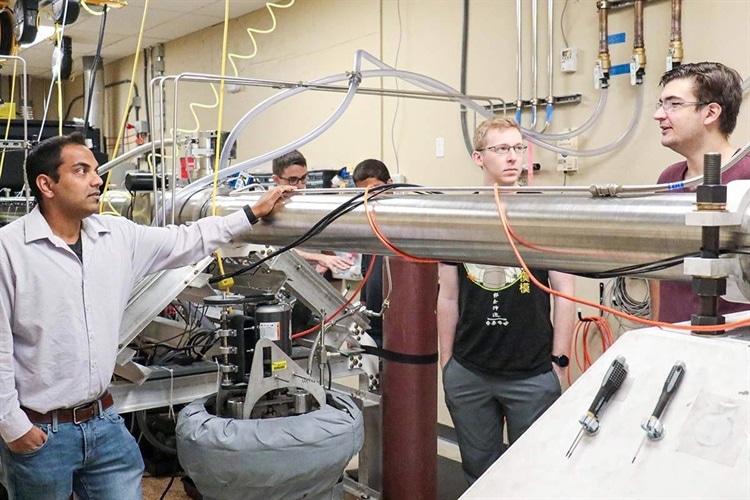
by Rick O'Connor | Oct 29, 2025
In 2011 many scientists, and executives from the oil and automobile industries, believed the energy source for the future was hydrogen. Most of the attention was focused on fuel cells that combine hydrogen and oxygen to produce electricity and emit water vapor into the atmosphere. As long as you did not use fossil fuels in the production of hydrogen, there would be no CO2 released. Another feather in it’s cap is that it produces more energy per gram than any other source of fuel – which would make it an excellent choice for aviation fuel. But there are challenges…
- it is found combined in other compounds – such as water, methane, and gasoline. So, it will take a lot of energy to produce it. More so than oil or coal.
- The electricity is produced in fuel cells, which can also be expensive.
- Whether this form of energy actually decreases CO2 levels would depend on how the hydrogen is extracted.
In 2011 there were several methods of storing hydrogen that were considered safe. Some were in operation, some were in development. It could be stored in a liquefied form or within compounds. Each of these methods posed no threats to catching fire, making their storage safer than fossil fuels. The automobile industry had developed prototypes of cars, trucks, and buses at the time. One engineer was working on a system that used pellets of aluminum-gallium alloy in water that could produce hydrogen. This could be done with the current gasoline tanks and would only require switching the fuel injector with a hydrogen injector and off we go. Large fuel cells could be used to heat and power buildings and homes. So, what happened? Why, in 2025, do we not see more of this source of energy in our lives?

Atomic Structure of Hydrogen & Periodic Table Listing
Several fossil fuel industries, such as ExxonMobil, Shell, and others, continue to state that hydrogen is in their future. The U.S. Energy Information Administration mentions that it is currently being used in industrial processing. They also mention fuel cells are currently being used to produce electricity for buildings and facilities – but as a backup source. Most of the fuel cells are using natural gas as the source of hydrogen – but some use biofuels generated from wastewater treatment plants, or landfill gas. In 2022, hydrogen still produced less than 1% of the country’s energy.
The high cost of fuel cells, and the limited number of hydrogen refueling stations, have hampered the development of fuel cell vehicles. It has been stated that people are reluctant to buy fuel cell cars if there are no refilling stations. And companies are reluctant to build refueling stations if there are no customers to use them. There are currently 60 hydrogen refueling stations in the country, all are in California. So, there has not been much movement towards the use of hydrogen since 2011.
At this point in the series on Our Environment, we have discussed the origin of humans, our dispersal across the planet, our need for resources such as food, space, and water, and our need for energy. We have discussed how these needs have stressed the environmental systems that support us – and all other creatures, and some solutions to many of these problems. But we began the series because our actions have led us to climate change – and it is time to come full circle and discuss this – which we will do in our next article.

New advancements in hydrogen fuel cells.
Photo: University of Central Florida.
References
Miller, G.T., Spoolman, S.E. 2011. Living in the Environment. Brooks/Cole Cengage Learning. Belmont CA. pp. 674.
ExxonMobil. Low Carbon Solutions. https://lowcarbon.exxonmobil.com/about-us/real-world-progress?utm_source=google&utm_medium=cpc&utm_campaign=1ELC_GAD_TRAF_OT_Non-Brand_Broad_Real+World+Progress_P3197SW&utm_content=OT_Non-Brand_General&utm_term=fuel+cell+systems&gclsrc=aw.ds&gad_source=1&gad_campaignid=21259280553&gbraid=0AAAAAp6NmRES_fRZTtbe44iCDN-OswsAJ&gclid=Cj0KCQjw8KrFBhDUARIsAMvIApbo-IZv3CmrxjiZR0r0ao9rMoFUPOtnwat2vbufe5fGKJbynITQk8oaAh5FEALw_wcB.
Hydrogen Explained; Use of Hydrogen. 2024. U.S. Energy Information Administration. https://www.eia.gov/energyexplained/hydrogen/use-of-hydrogen.php.

by Rick O'Connor | Oct 21, 2025
Geothermal is one source of energy that has been explored, and utilized, in recent decades. It is heat which is stored beneath the earth – either in the soil, rocks, or the fluid portion of the mantle. It has been used primarily in heating our homes and producing electricity. The amount of geothermal energy within the crust leads to it having great potential for us.
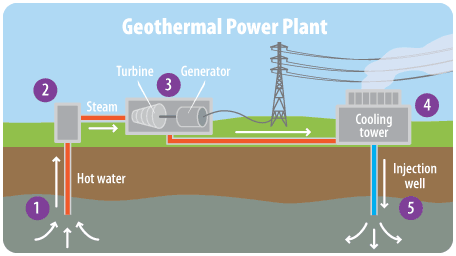
How Geothermal Energy Works – EPA
Many around the world are using a geothermal heat pump system where pipes in a closed system filled with water, or another antifreeze type fluid, buried between 10-20 feet in the yard can move heat from the ground into the home during winter, and reverse the process during summer. If the house is insulated properly, the US EPA considers this method the most efficient one for heating and cooling your home.
Iceland is famous for their use of geothermal energy. Drilling pipes beneath the earth, they are using hot steam and water to heat buildings, provide hot water, grow vegetables in greenhouses, raise fish in aquaculture ponds, and spin turbines to produce electricity. The island is, of course, an active volcano – and that helps.
In 2011 over 40 countries had developed geothermal districts which were producing about 1% of the world’s electricity. The amount of electricity generated was equal to 104 nuclear power plants. In 2022 the United States had 3,965 geothermal plants in operation – the most in the world. The majority of these are in California, Nevada, Utah, and Hawaii.
In general, geothermal has less environmental impact than fossil fuels. If located near a good source, the cost is much lower to produce. However, there are two main problems. One, the cost of tapping into the system from locations far from the sources is high. Second, we could actually remove the dry or wet steam faster than the earth can replace them. Below are additional pros and cons.
| Advantages |
Disadvantages |
| Very high efficiency |
Scarcity of suitable sites |
| Moderate net energy at suitable sites |
CO2 emissions |
| Lower CO2 emissions than fossil fuels |
Moderate to high local air pollution |
| Low cost at favorable sites |
Noise and odors (hydrogen sulfide gas) |
| Low land use and disturbance |
High cost except at suitable sites |
There is one more source of energy to look at – hydrogen – and we will explore that one in the next article.
References
Geothermal Energy Fact Sheet. The Center for Sustainable Systems. University of Michigan. https://css.umich.edu/publications/factsheets/energy/geothermal-energy-factsheet.
Miller, G.T., Spoolman, S.E. 2011. Living in the Environment. Brooks/Cole Cengage Learning. Belmont CA. pp. 674.
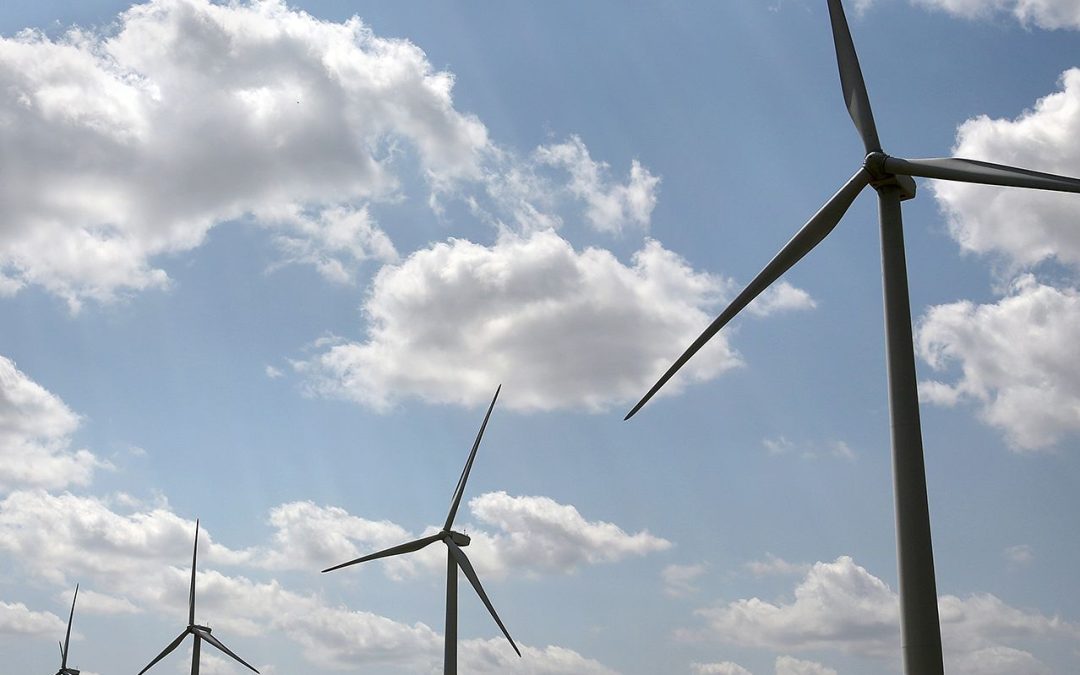
by Rick O'Connor | Sep 22, 2025
Wind power has become more popular across the planet. Though some regions of the Earth get more wind than others – it blows basically everywhere. The concept behind wind energy is the same as hydroelectric power. In hydroelectric moving water turns the turbines to generate electricity – with wind power it is moving air.
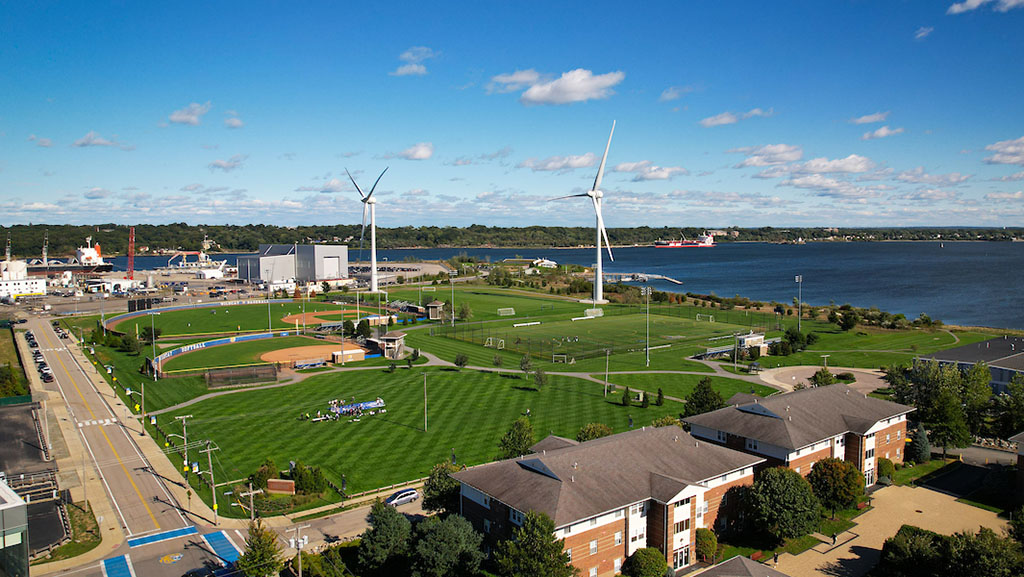
photo: Sam Ho 2022
One study conducted at Stanford by C.I. Archer and M.Z. Jacobsen in 2004 mapped the global potential for wind energy. Their data suggested that capturing only 20% of this potential energy from the world’s best sites could generate seven times more energy than was being developed in 2011 and thus could help phase out coal and nuclear power sources. Offshore wind production looks promising as well. Out there – the wind can be stronger and steadier than winds over land. Many countries have already developed offshore wind farms. Over land within the U.S., areas near the Rocky Mountains show the best promise – and many of these areas have already developed wind farms. In 2011 scientists estimated that wind farms in North Dakota, South Dakota, Kansas, and Texas alone could generate three times more energy than all of the power plants operating at that time. This looks like a promising option for fossil fuels, but there are challenges.
- Areas where wind energy is most promising have few people – the energy would have to transported to more urban sites.
- Winds do die down and a backup source will be needed in many locations.
- Studies have found that rotating wind turbines kill as many as 40,000 birds and bats each year in the U.S. alone.
- Many urban and coastal communities resist them because they are unsightly and noisy.
Others
| Advantages |
Disadvantages |
| Moderate to high energy yield |
Steady winds needed |
| High energy efficiency |
Backup systems needed during low wind events |
| Moderate capital costs |
High land use required |
| Low electricity costs |
“Visual” pollution |
| Very low environmental impact |
Noise when located near populated areas |
| No carbon dioxide emissions |
Can kill birds and bats |
| Can be located at sea |
|
| Land below turbines can be used for agriculture |
|
In the next article we will look at using biomass as an energy source.
Reference
Miller, G.T., Spoolman, S.E. 2011. Living in the Environment. Brooks/Cole Cengage Learning. Belmont CA. pp. 674.

by Rick O'Connor | Sep 8, 2025
We will begin our look at solar energy by explaining there are two forms – passive and active. In passive solar energy the well insulated building is heated directly from the sun without the need for additional technologies. In active solar energy the build has solar panels. These panels have a heat-absorbing fluid which collects solar energy and can use it directly within the house or store it for later use. Here are some advantages and disadvantages of passive or solar heating.
| Advantages |
Disadvantages |
| Energy is free |
Need access to the sun 60% of the time |
| Quick installation |
Sun can be blocked by trees and other structures |
| No CO2 emissions |
Need a heat storage system |
| Very low air and water pollution |
High cost |
| Very low land disturbance |
Active systems need maintenance and repairs |
|
Active collectors can be unattractive |
Another problem is that most solar energy designs are designed to heat the buildings, not cool – but there are technologies that can help with this – such as:
- Block summer sun with window overhangs and awnings.
- Use a light-colored roof to reflect as much as 80% of the sun’s heat.
- Suspend reflective insulating foil in the attic to block heat from radiating into the house.
- Place plastic earth tubes into the ground where the earth is cool year-round. Tiny fans can pipe cool air into the house when needed.
- Use geothermal heat pumps.
Can solar energy be used for high-temperature heat demands – such heating water and generating steam for electricity?
It can, but there are trade-offs.
| Advantages |
Disadvantages |
| Moderate net energy |
Low efficiency |
| Moderate environmental impact |
High costs |
| No CO2 emissions |
Needs back up and storage systems |
| Fast construction (1-2 years) |
Needs access to the sun most of the time |
|
Vulnerable to sabotage |
|
Land use that could be used for other resources |
Solar cells can be used to produce electricity directly. This electricity can be used directly within the building or stored for later use. This electricity can be connected to the grid and some countries require power companies to purchase excess electricity produced by homes placed on the grid. These solar cells have no moving parts, are safe and quiet, require little maintenance, produce no pollution, and last as long as conventional fossil fuel and nuclear energy sources. There are some issues…
| Advantages |
Disadvantages |
| Fairly high net energy yield |
Need access to the sun |
| They work on cloudy days |
Need storage and back up systems |
| Quick installation |
High costs |
| Easily expanded or moved |
High land use |
| No CO2 emissions |
DC current must be converted to AC |
| Low environmental impact |
|
| Last 20-40 years |
|
As many already know, Florida Power and Light has already invested in this technology – as has the U.S. military. In our next article we will look at producing electricity from the water cycle.
References
Miller, G.T., Spoolman, S.E. 2011. Living in the Environment. Brooks/Cole Cengage Learning. Belmont CA. pp. 674.

by Rick O'Connor | Aug 25, 2025
Over the last couple of articles, we have seen how humans moved from a wood-based energy source to coal and from coal to oil. With the onset of the industrial revolution, new innovations such as electricity and transportation, our energy needs have increased – along with our population.
In Part 16 we looked at the advantages and disadvantages of continuing using fossil fuels for our energy needs. We also looked at nuclear energy. Many feel that these pros and cons are sufficient enough to continue with fossil fuels – for now. Others, including some energy companies, believe it is time to look for other alternatives. It is estimated that fossil fuels will last another 200-500 years, and as we get closer to those deadlines, prices will go up. And then there is the concern surrounding the environmental impacts of burning fossil fuels. Enter the renewables.

We can begin by making our homes, businesses, and vehicles more energy efficient.
Photo: UF IFAS
Miller and Spoolman1 begin their chapter on this topic but discussing energy efficiency – the idea of using our current energy sources more wisely and, possibly, extending the deadline. Many of us already use energy efficient appliances, energy efficient building designs, and energy efficient cars. Some of this is forced on us. Some are to help us reduce our energy costs. But this movement has already begun. Data from the U.S. Department of Energy in 2011 stated that fossil fuels accounted for 85% of our energy input. 84% of that energy became unavoidable energy waste (41%) and unnecessary energy waste (43%). Only 9% were converted into useful energy. The incandescent light bulb uses only 5-10% of its energy to produce light, the rest is lost as heat. 94% of the energy in the internal combustion engine is lost as heat. Only 34% of the energy used to burn coal actually becomes electricity.
In 2011 industry accounted for 30% of the worlds, and 38% of the U.S., energy consumption. Miller and Spoolman provide methods in which industry can become more energy efficient.
- Replace energy-wasting electric motors.
- Recycle materials like steel and other metals.
- Switch from low-efficient incandescent to fluorescent or LED lighting.
Many industries have already made such changes.
In 2011, transportation accounted for 67% of the oil consumption in the U.S. During the 1970s the federal government began requiring fuel efficient cars and trucks. Fuel efficiency increased until about 1985 were it peaked – it has remained at this level since. Though vehicles are more fuel efficient than they were in the 1960s, U.S. consumers still prefer large trucks and SUVs to more fuel-efficient vehicles. There has been recent interest in electric vehicles. But recent reports suggest some automakers may be reducing their inventory of such cars and trucks.
There is a whole new industry in energy efficient buildings – “green buildings”. Most of our buildings were not designed with energy efficiency in mind. For those there are some things we can do to improve energy efficiency.
- Insulate and plug leaks. Over 30% of American homes lose their heated air through holes, cracks, and single paned windows.
- Energy efficient windows. This can reduce heat/AC loss by over 50%.
- Use more energy efficient appliances.
- Use more energy efficient lighting.
Other suggestions within the home include;
- The attic. Hang reflective foil to reflect heat. Use a house fan. Be sure attic insulation is at least 12 inches thick.
- Install water saving toilets, faucets, and shower heads. Repair water leaks.
- Use microwave as much as possible. Run only full loads in the dishwater and use low – or no-heat – drying. Clean refrigerator coils regularly.
- Other rooms. Use compact fluorescent lighting and LED lighting. Turn off lights, TV, computers when not in use. Set the thermostat as low as possible in the winter, and as high as possible in the summer. Weather strip and caulk doors and windows. Use fans.
- Plant trees to shade/cool house.
In our next article we will begin looking at new forms of energy that could replace fossil fuels.
References
Miller, G.T., Spoolman, S.E. 2011. Living in the Environment. Brooks/Cole Cengage Learning. Belmont CA. pp. 674.












